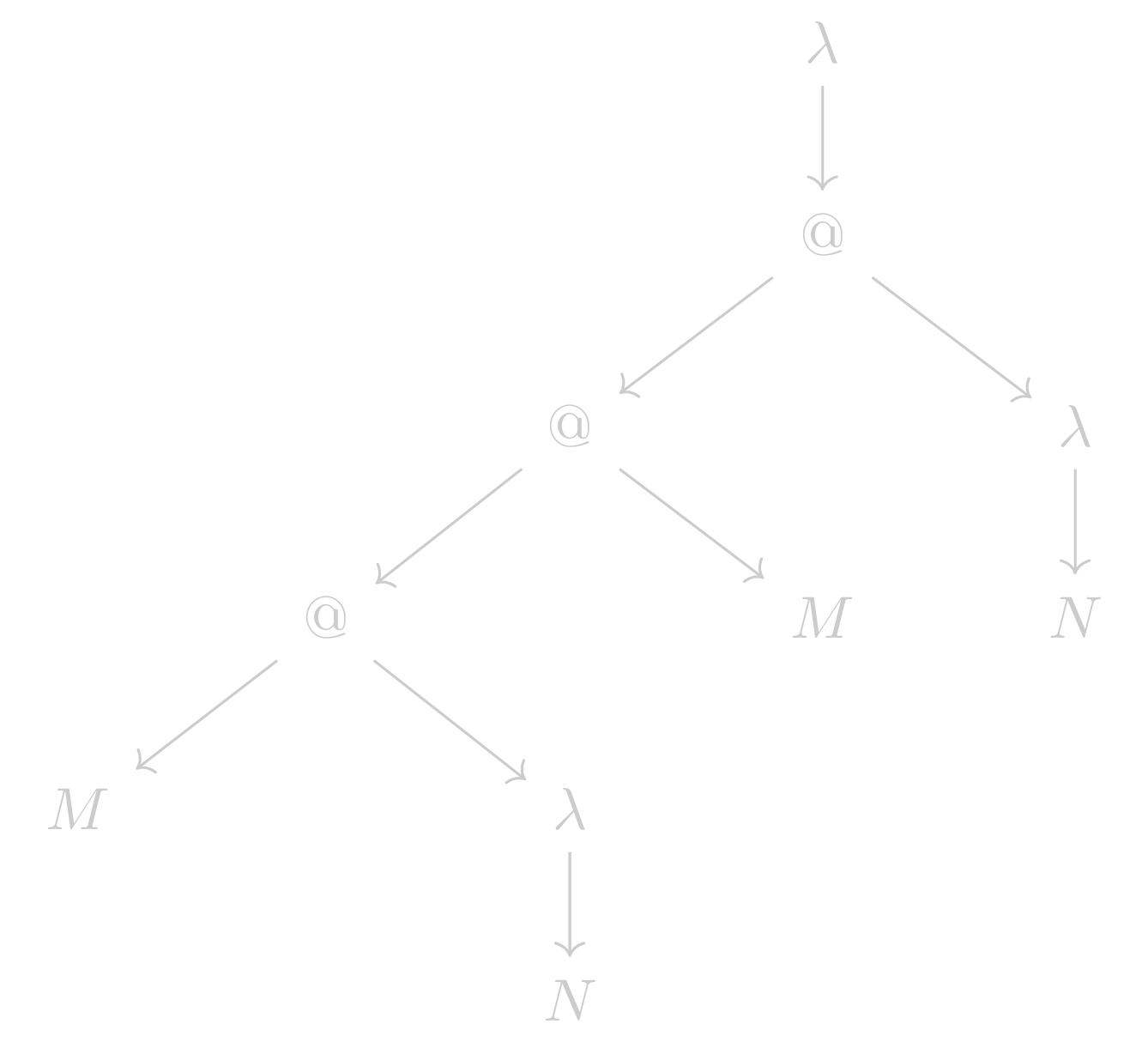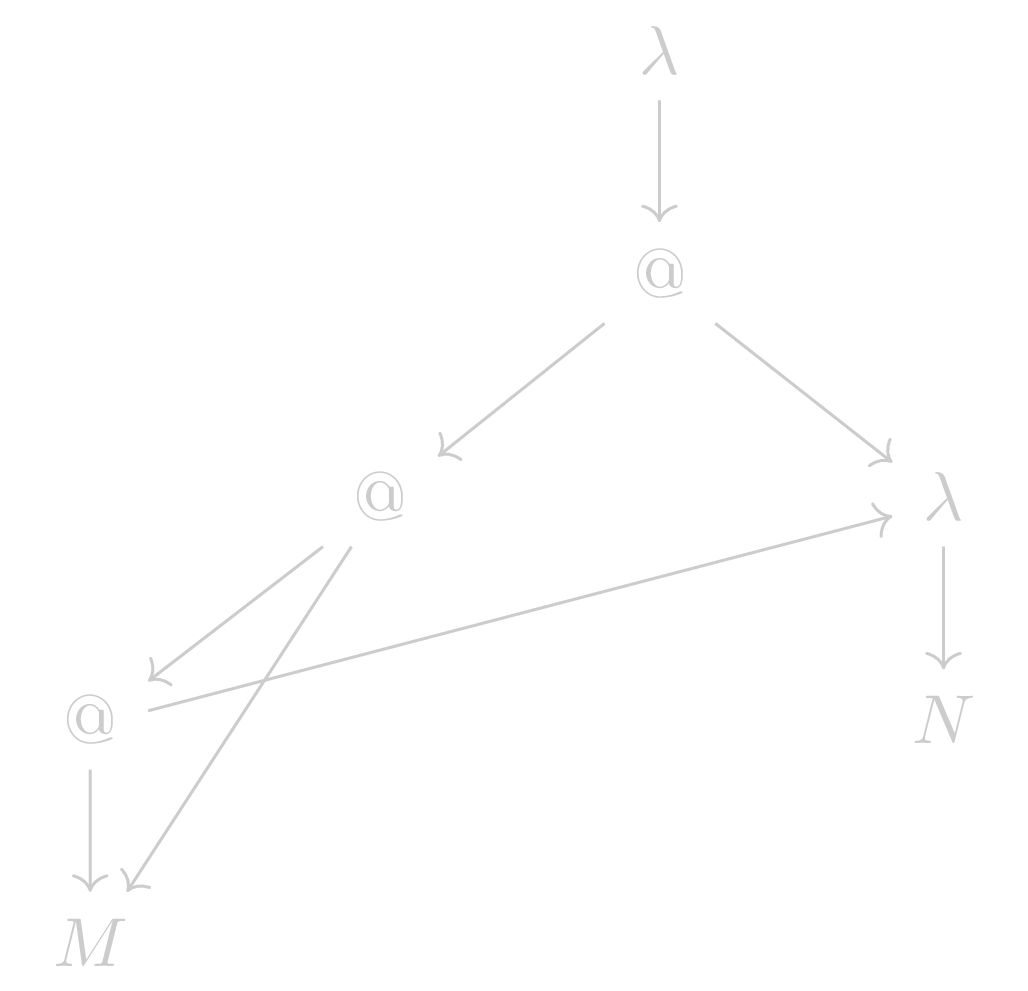
2023-05-30
Lambda calculus expressions can get really big, not only for actual encoded programs, but also for data encodings. This is because lambda calculus, due to its simplicity, doesn’t inherently support any kind of sharing or stored substitution bindings outside of abstractions.
For example, take the expression
E=λx.(((M λy.N) M) λz.N). Its obvious encoding would always
involve multiple copies of M, N. Not only
that, but standard reduction strategies would needlessly evaluate the
copied expressions multiple times.
One common way of solving this problem is to introduce
let-bindings. This doesn’t really help me if I want to
reduce and store pure lambda calculus expressions more
efficiently, though.
There have been other solutions to the problem, notably by Accattoli et. al.. I, however, want to present an approach using hashes.
I want to generate a list of all expressions without any duplicates. The duplicates would then be referred to by some kind of index (e.g. memory address).
Let’s use the previous example expression E: Assuming
M and N do not in turn contain existing terms,
the list should, aside from the other constructs, contain only a single
copy of N and M. Furthermore, the list should
also only contain one copy of λy.<N> (with
<N> being a reference to the actual N in
the list).
Using this list would then make it easy to store the expression more efficiently (see BLoC), but more importantly, one could utilize the removed duplications to “parallelize” the reduction of such expressions.
Due to the complexity of the algorithms regarding -conversion and -equivalence, we convert the bound variables to de Bruijn indices.1
Terms can then be represented using this abstract syntax tree (AST) definition:
data Term = Abs Term | App Term Term | Var IntThis enables us to derive an initial -equivalency algorithm:
equiv :: Term -> Term -> Bool
equiv (Abs x) (Abs y) = (equiv x) && (equiv y)
equiv (App x1 x2) (App y1 y2) = (equiv x1 y1) && (equiv x2 y2)
equiv (Var x) (Var y) = x == y
equiv _ _ = FalseFinding duplicate expressions would then come down to a quadratic brute-force search over all terms. I hope it’s obvious how this has a horrible time complexity – we need a different approach for evaluating equivalence.
My main idea is to assign a hash to every sub-expression of an
expression, such that comparing the hashes of two terms behaves the same
as the previously described equiv function.
I assume a hash function with data and seed . While the individual hashes should have a fixed size, we ignore hash-collisions for now by assuming that is injective or perfect. A reasonable way of hashing lambda expressions would then be:
hash :: Term -> Hash
hash (Abs x) = H 1 (hash x)
hash (App x y) = H (H 2 (hash x)) (hash y)
hash (Var x) = H 3 xThere are obviously many different ways of doing this and the
seed parameter isn’t actually needed at all. It makes it a
bit easier to avoid collisions, though.
While we could now apply this function on every single sub-expression individually, we can also calculate the hashes in a bottom-up fashion.
To give some intuition behind this part, let’s visualize the AST of
E:

We now use the postorder tree traversal strategy (starting from the bottom left) to hash every sub-tree:
hash M -> hash N -> hash λN -> hash (M λN) -> hash M -> ...This way, every parent just uses the previously calculated hashes of their child as input for their hash functions such that every term gets hashed exactly once.
To get the desired result of a list of non-duplicate expressions, we can easily modify the tree traversal of the hashing procedure by adding the expression and its hash to a hashmap.
If we execute this procedure while constructing (e.g. while parsing) the expression in the first place, we potentially eliminate many redundant term allocations, as we can calculate the hash of an expression beforehand to check whether it exists in the hashmap already. The parent expression would then get the reference of the matching expression that was found in the hashmap. This reference could be a hash or a pointer. An implementation of this algorithm can be found in my calm project.
The previously ignored problem of hash collisions is not easily avoidable. If a hash collision occurs, a parent might get a reference to the wrong expression. While it’s possible to detect a hash collision, by just comparing the sub-hashes (single level) of the existing expression in the hashmap, it’s not possible to bypass the problem completely (as far as I know).
During extensive testing using 64-bit hashes (xxHash), I
never had a single hash collision – even with 500MB of bit-encoded BLC
expressions. One way to further reduce the possibility would obviously
be to use an even wider hash.
We could also store the bitwise BLC encoding of every term and use it in a mapping similar to a hashmap. This would keep the advantages of bottom-up building but would obviously have a massive time and memory complexity with big expressions.
Applying the described algorithm to E results in the
following graph:

Such a graph is called a shared -graph and is – as a matter of fact – a directed acyclic graph (DAG), enabling us to apply many nifty tricks on it.
The derivation of shared -graphs from expressions in lambda calculus is essential for its efficient reduction and storage.
The presented algorithm achieves this with linear complexity while having the drawback of potential hash collisions.
You can find a full reference implementation including an algorithm for “sharing equality” here.
Thanks for reading. Suggest improvements or fixes via email. Discuss on reddit. Support on Ko-fi.
Imprint · AI Statement · RSS